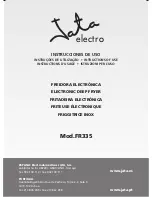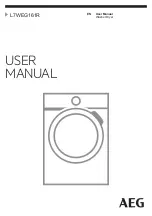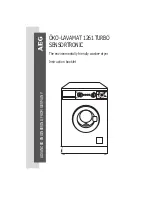
27
6.7 Cu. Ft. Front-Load Electric and Gas Dryers
www.insigniaproducts.com
USER MAINTENANCE INSTRUCTIONS
Cleaning and inspecting the exhaust system
Inspect and clean the exhaust yearly to maintain optimum performance.
1
Disconnect the exhaust duct from the dryer and from the exhaust hood (at the exhaust outlet) outside of the
building.
2
Check the interior of the duct and remove any lint accumulation.
3
Make sure that lint is removed from the exhaust hood. Lint may collect in the exhaust hood so that the flappers
or louvers will not open or close completely.
4
After cleaning the exhaust hood, check that the flapper or louvers move freely.
5
Reassemble the exhaust duct and hood, making sure that the joints are secure and sealed.
6
Operate your dryer and make sure that the exhaust air is not obstructed in the vent and that there are no leaks
in the system.
Troubleshooting
Note
Check and clean the outside exhaust hood
frequently to ensure a proper air flow.
Caution
Do not try to repair your dryer yourself.
Doing so invalidates the warranty.
PROBLEM
SOLUTION
Dryer does not start.
• Confirm that the Child Lock is not on.
• Make sure the dryer door is closed completely.
• If you opened the door during the drying cycle, press the
/START PAUSE
button again.
• Make sure that the power cord is plugged into a working electrical outlet.
• Check the circuit breaker and fuses for your dryer’s electrical connection.
Dryer does not heat
or does not dry.
• Your dryer may have moved into the cool-down process of the cycle. This is normal.
• Select a cycle other than
Air Fluff
and a temperature setting that is not “no heat.”
• Do not overload your dryer. Depending on the size of your washer, one wash load should
equal one dry load.
• Dry heavy items and lightweight items separately.
• If you are drying large, bulky items, like blankets or comforters, try repositioning the load to
ensure even drying.
• The load may be too small to tumble correctly. Add a few towels.
• Clean the lint filter and exhaust duct.
• Check the circuit breaker and fuses for your dryer’s electrical connection.
• Make sure that the outside exhaust hood opens and closes freely.
• Check the exhaust system for lint buildup. Ducting should be inspected and cleaned
annually.
• Make sure that your exhaust duct is a 4" rigid metal duct.
Dryer is noisy.
• It is normal for your dryer to hum due to the high velocity of air moving through the dryer
drum and exhaust system.
• Check the load for objects, like coins, loose buttons, nails, or broken zippers. Remove these
items.
• Make sure that your dryer is level.
Clothes are
unevenly dried.
• Seams, pockets, and other similarly heavy areas may not be completely dry when the rest of
the load has reached the selected dryness level. This is normal. Select the
More
or
Very
dryness level if desired.
• If you dry one heavy item with a lightweight load (such as one towel with sheets), the heavy
item may not be completely dry when the rest of the load has reached the selected dryness
level. For best drying results, dry heavy items and lightweight items separately.
Dryer shuts off
before clothes are
dried.
• The dryer load is too small. Add more items or a few towels and restart the cycle.
• The dryer load is too large. Remove some items and restart the cycle.
Dryer has an odd
odor.
• Your dryer draws air from the surrounding room air. Household odors from paint, varnish,
strong cleaners, and so forth, may enter your dryer with the surrounding room air. This is
normal. When these odors linger in the air, ventilate the room completely before using your
dryer.
NS-FDRE67WH8A-C_NS-FDRE67WH8A_NS-FDRG67WH8A_17-0815_MAN_V5_EN.fm Page 27 Wednesday, November 15, 2017 12:25 PM




































